The History of the Moon
Card
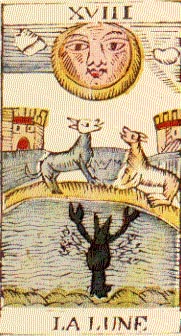 The
Moon is a card that the occultists modified very little. In the
Waite-Smith deck, for example, the design is almost indistinguishable
from the centuries-old Tarot de Marseille pattern. In the foreground
is a pool with a lobster or crawfish arising from the waters. In the
middle distance, two dogs (or a dog and a wolf) stand howling at the
moon. In the distance, two hills are topped with towers. The Moon
herself shines serenely down on the scene, sometimes partly obscured
by clouds.
The
Moon is a card that the occultists modified very little. In the
Waite-Smith deck, for example, the design is almost indistinguishable
from the centuries-old Tarot de Marseille pattern. In the foreground
is a pool with a lobster or crawfish arising from the waters. In the
middle distance, two dogs (or a dog and a wolf) stand howling at the
moon. In the distance, two hills are topped with towers. The Moon
herself shines serenely down on the scene, sometimes partly obscured
by clouds.
The old Italian tarot designs, outside the influence of the Tarot
de Marseille, show completely different scenes on the card. In the
Tarocco Bolognese, we see two astronomers, apparently debating
beneath a moonlit sky that also features several stars. One holds a
compass and globe, the other a T-square. This theme is echoed in the
Minchiate of Florence, where an astronomer with compass gazes upward,
"moonstruck"; he sits with a massive disk bearing the Roman numerals
I through XII, both a sundial or clock and a reference to the signs
of the zodiac. In the Tarocco Siciliano, a woman stands gesturing
toward a man lying sleeping beneath a tree, a discarded club by his
side.
Although the female maiden or goddess as a Moon symbol was a
veritable cliche of Renaissance art, only a few early tarot decks
show this obvious motif: Mitelli's 1665 engraved deck shows Diana,
complete with her hunting dogs. The Visconti-Sforza triumph cards
show a modestly clothed maiden holding the Moon in her hand. This
card (and several others in the deck) was almost certainly not made
in Milan, but is instead a "replacement" made in Ferrara, perhaps in
the 1460s or 1470s, to complete the deck. Neither of these "Moon
goddesses" apparently had much of an influence on subsequent tarot
designs.
In the Belgian Tarot (17th to 18th centuries), we see a woman with
a spindle, a design apparently borrowed from the Ferrarese or
Bolognese Sun card design.
The Swiss 1JJ Tarot (a modern design with 19th-century
antecedents, related to the Tarot de Marseille) keeps the lobster and
one of the dogs, but adds a romantic serenader and his
balcony-ensconced lover.
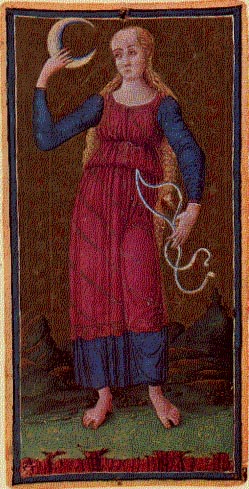
|
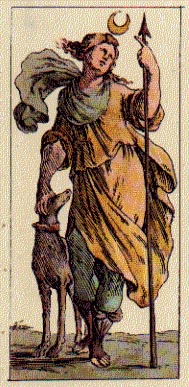
|

|
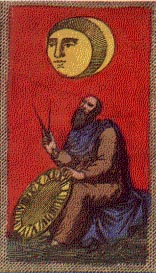
|
|
Visonti-Sforza Triumph Cards, c.1450
|
Tarocchino di Mitelli, c.1665
|
Belgian Tarot, 1770
|
Minchiate Fiorentine, c. 1820
|
 The
Tarot de Marseille design looks rather unusual in the company of the
Italian cards with their astronomers and allegorical Moon maidens,
and it was once thought that this was a rather late (17th century)
variations. However, an uncut sheet of cards (the Cary sheet) from
Milan in the early 1500s shows a very similar design; lacking only
the dogs. so there is a possibility that this eerie nighttime scene,
lacking human figures, dates back to the very earliest days of the
tarot.
The
Tarot de Marseille design looks rather unusual in the company of the
Italian cards with their astronomers and allegorical Moon maidens,
and it was once thought that this was a rather late (17th century)
variations. However, an uncut sheet of cards (the Cary sheet) from
Milan in the early 1500s shows a very similar design; lacking only
the dogs. so there is a possibility that this eerie nighttime scene,
lacking human figures, dates back to the very earliest days of the
tarot.
The "lobster" is almost certainly meant to represent the
astrological sign of Cancer (many old manuscripts show "crabs" drawn
like lobsters). So this design, although rather mysterious to modern
eyes, was probably completely logical and pedestrian to 16th-century
sensibilities. Rather it is the Italian cards with astronomers and
compasses that seem to demand explanation: these were classic icons
of astronomy or astrology, and hence (one would think) more
appropriate to the Star card.
 The
sequence of tarot trumps is almost explicable as a cosmograph, or
symbolic map of the universe. The "celestial spheres" (Star, Moon,
and Sun) are grouped together, just before emblems of heaven and God
(the Angel and the World), reflecting the conventional understanding
of the cosmic order. But there is a peculiarity: the Star appears
before Moon and Sun, not after them as the wisdom of the times would
have dictated. What gives?
The
sequence of tarot trumps is almost explicable as a cosmograph, or
symbolic map of the universe. The "celestial spheres" (Star, Moon,
and Sun) are grouped together, just before emblems of heaven and God
(the Angel and the World), reflecting the conventional understanding
of the cosmic order. But there is a peculiarity: the Star appears
before Moon and Sun, not after them as the wisdom of the times would
have dictated. What gives?
It may be that the tarot designer was thinking more of "increasing
power" than of astronomical location: Moon is brighter than Star, Sun
is brighter than Moon. It may also be that the Star is meant to
signal the celestial spheres generally (the tarot has no cards
explicitly depicting the spheres of the planets). with the Moon and
Sun singled out for special treatment. 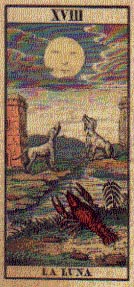 This
possibility is especially appealing to me, as the Moon and Sun are
traditional celestial symbols of the female/male duality, a theme
that seems to permeate the tarot. (The tarot designer felt obliged to
include a male and female pope, a male and female emperor, and both
kings and queens for each suit, at a time when the norm cosisted of a
thoroughly male hierarchy of powers.) It seems to me that the tarot
designer wanted symbols of the male and female principles (Sun and
Moon) positioned at the very top of the celestial realm, just below
the heavens themselves, to emphasize the importance of this
dichotomy.
This
possibility is especially appealing to me, as the Moon and Sun are
traditional celestial symbols of the female/male duality, a theme
that seems to permeate the tarot. (The tarot designer felt obliged to
include a male and female pope, a male and female emperor, and both
kings and queens for each suit, at a time when the norm cosisted of a
thoroughly male hierarchy of powers.) It seems to me that the tarot
designer wanted symbols of the male and female principles (Sun and
Moon) positioned at the very top of the celestial realm, just below
the heavens themselves, to emphasize the importance of this
dichotomy.
As unappetizing as it is to modern minds, we must recognize that
throughout most of western history, the female principle was regarded
as negative and inferior to the male principle. The Moon is outranked
by the Sun, and furthermore presides over the uncomfortable, possibly
frightening, world of the night. Many of these associations (deceit,
ill omen, confusion, indecision) still cling to the Moon card in
divinatory traditions. The original tarot designers, though certainly
steeped in the patriarchal culture of old Europe, may have valued the
feminine principle more than these cliches would suggest. Certainly
the queens, Papess, and Empress are presented just as positively in
the old decks as their male counterparts. Perhaps the original
designers of the tarot were informed by a philosophy that regarded
the feminine principle as essential (if nevertheless alien to the
social norms of the time), and so they elevated the Moon above the
Stars to (near) parity with the Sun, so that both male and female
principles become indispensible templates for the entire created
cosmos.
Return to the Histories of the Trump
Cards

Copyright 1999 Tom Tadfor Little
 The
Moon is a card that the occultists modified very little. In the
Waite-Smith deck, for example, the design is almost indistinguishable
from the centuries-old Tarot de Marseille pattern. In the foreground
is a pool with a lobster or crawfish arising from the waters. In the
middle distance, two dogs (or a dog and a wolf) stand howling at the
moon. In the distance, two hills are topped with towers. The Moon
herself shines serenely down on the scene, sometimes partly obscured
by clouds.
The
Moon is a card that the occultists modified very little. In the
Waite-Smith deck, for example, the design is almost indistinguishable
from the centuries-old Tarot de Marseille pattern. In the foreground
is a pool with a lobster or crawfish arising from the waters. In the
middle distance, two dogs (or a dog and a wolf) stand howling at the
moon. In the distance, two hills are topped with towers. The Moon
herself shines serenely down on the scene, sometimes partly obscured
by clouds.



 The
Tarot de Marseille design looks rather unusual in the company of the
Italian cards with their astronomers and allegorical Moon maidens,
and it was once thought that this was a rather late (17th century)
variations. However, an uncut sheet of cards (the Cary sheet) from
Milan in the early 1500s shows a very similar design; lacking only
the dogs. so there is a possibility that this eerie nighttime scene,
lacking human figures, dates back to the very earliest days of the
tarot.
The
Tarot de Marseille design looks rather unusual in the company of the
Italian cards with their astronomers and allegorical Moon maidens,
and it was once thought that this was a rather late (17th century)
variations. However, an uncut sheet of cards (the Cary sheet) from
Milan in the early 1500s shows a very similar design; lacking only
the dogs. so there is a possibility that this eerie nighttime scene,
lacking human figures, dates back to the very earliest days of the
tarot. The
sequence of tarot trumps is almost explicable as a cosmograph, or
symbolic map of the universe. The "celestial spheres" (Star, Moon,
and Sun) are grouped together, just before emblems of heaven and God
(the Angel and the World), reflecting the conventional understanding
of the cosmic order. But there is a peculiarity: the Star appears
before Moon and Sun, not after them as the wisdom of the times would
have dictated. What gives?
The
sequence of tarot trumps is almost explicable as a cosmograph, or
symbolic map of the universe. The "celestial spheres" (Star, Moon,
and Sun) are grouped together, just before emblems of heaven and God
(the Angel and the World), reflecting the conventional understanding
of the cosmic order. But there is a peculiarity: the Star appears
before Moon and Sun, not after them as the wisdom of the times would
have dictated. What gives? This
possibility is especially appealing to me, as the Moon and Sun are
traditional celestial symbols of the female/male duality, a theme
that seems to permeate the tarot. (The tarot designer felt obliged to
include a male and female pope, a male and female emperor, and both
kings and queens for each suit, at a time when the norm cosisted of a
thoroughly male hierarchy of powers.) It seems to me that the tarot
designer wanted symbols of the male and female principles (Sun and
Moon) positioned at the very top of the celestial realm, just below
the heavens themselves, to emphasize the importance of this
dichotomy.
This
possibility is especially appealing to me, as the Moon and Sun are
traditional celestial symbols of the female/male duality, a theme
that seems to permeate the tarot. (The tarot designer felt obliged to
include a male and female pope, a male and female emperor, and both
kings and queens for each suit, at a time when the norm cosisted of a
thoroughly male hierarchy of powers.) It seems to me that the tarot
designer wanted symbols of the male and female principles (Sun and
Moon) positioned at the very top of the celestial realm, just below
the heavens themselves, to emphasize the importance of this
dichotomy.